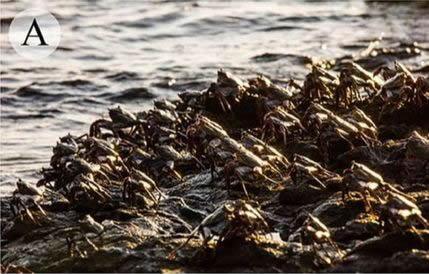News
Importance of Aratu crab (Grapsus grapsus) in St. Peter and St. Paul’s Archipelago
2019, September

In a place of intense endemism and low diversity of species, the Aratu Crab (Grapsus grapsus) plays a key role in the reef environment, strongly acting as a connection between the intertidal and subtidal reef environment. Considering that in the western South Atlantic G. grapsus occurs only in the Brazilian oceanic islands and that the ASPSP population is maintained by self-recruitment, without considerable dispersion of the species, long-term monitoring of the Aratu Crab populations is justified, not only because of its direct influence on the reef pelagic system, but also because it signals the environmental conditions of adjacent rocky shores. When assessing the results of the ASPSP monitoring over the last few years, performed by counting G. grapsus at 10 transects and by subsequent analysis of the structure of 100 individuals, there is a tendency of a decreasing abundance of crabs, a decreasing size of ovigerous females and an increasing proportion of mutilated organisms over time. Therefore, there is a need for a longer period of monitoring, since if the trend of these parameters is confirmed, a change in the environmental factors of the archipelago and a decrease in the fecundity rate and supply of larvae to the reef environment are revealed. The whole article is available in the book chapter “Temporal Variation of the Preserved Communities in the São Pedro and São Paulo Archipelago: Actions of the Long-Term Monitoring Project (PELD/ILOC).
St. Peter and St. Paul’s Archipelago reef fish assemblage
2019, September

The archipelago of St. Peter and St. Paul’s is a set of Brazilian oceanic islands farther from the coast. It is a place well preserved and, thus, of particular importance for marine biodiversity. In St. Peter and St. Paul’s Archipelago the PELD-ILOC aims to carry out monitoring of this biodiversity, especially of the ichtyofauna, providing important information which show more and more the specialty of this place. St. Peter and St. Paul’s Archipelago has the lowest diversity of fishes in the South Atlantic, but, however, a high rate of endemism. We find species with different morphologies and different color patterns that do not occur in other islands of the Atlantic. Until a depth of 50 m, the St. Peter and St. Paul’s Archipelago reefs are well known compared to other Atlantic Islands. Recent expeditions have investigated the mesophotous fish, that occurs between 30 and 90 meters depth, a hitherto little described habitat. Since 2013, the monitoring of the ichthyofauna has been performed annually. It was observed that about 90% of the fish analyzed in the first year, were again observed in the following years. In these years, there were events of fish biomass and density being related to the large number of species. The species size has increased little during the years with carnivorous species increasing especially in the first years decreasing to their average size within the last two years. Furthermore, there was no shark species recorded during any expeditions. This article is available in the book chapter “Temporal Variation of the Preserved Communities in the St. Peter and St. Paul’s Archipelago: Actions of the Long-Term Monitoring Project (PELD-ILOC), see also “Publications”.
- « Previous
- 1
- 2
- 3
